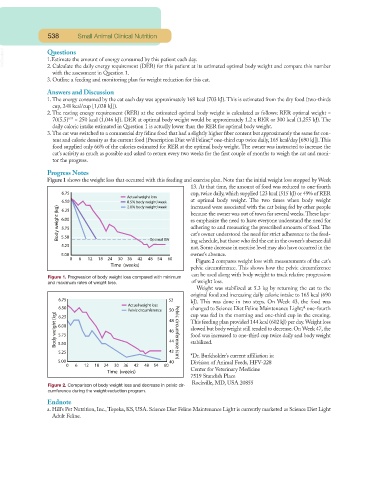Page 522 - Small Animal Clinical Nutrition 5th Edition
P. 522
538 Small Animal Clinical Nutrition
VetBooks.ir Questions
1.Estimate the amount of energy consumed by this patient each day.
2. Calculate the daily energy requirement (DER) for this patient at its estimated optimal body weight and compare this number
with the assessment in Question 1.
3. Outline a feeding and monitoring plan for weight reduction for this cat.
Answers and Discussion
1. The energy consumed by the cat each day was approximately 168 kcal (703 kJ). This is estimated from the dry food (two-thirds
cup, 248 kcal/cup [1,038 kJ]).
2. The resting energy requirement (RER) at the estimated optimal body weight is calculated as follows: RER optimal weight =
70(5.5) 0.75 = 250 kcal (1,046 kJ). DER at optimal body weight would be approximately 1.2 x RER or 300 kcal (1,255 kJ). The
daily caloric intake estimated in Question 1 is actually lower than the RER for optimal body weight.
3. The cat was switched to a commercial dry feline food that had a slightly higher fiber content but approximately the same fat con-
a
tent and caloric density as the current food (Prescription Diet w/d Feline; one-third cup twice daily, 165 kcal/day [690 kJ]).This
food supplied only 66% of the calories estimated for RER at the optimal body weight. The owner was instructed to increase the
cat’s activity as much as possible and asked to return every two weeks for the first couple of months to weigh the cat and moni-
tor the progress.
Progress Notes
Figure 1 shows the weight loss that occurred with this feeding and exercise plan. Note that the initial weight loss stopped by Week
13. At that time, the amount of food was reduced to one-fourth
cup, twice daily, which supplied 123 kcal (515 kJ) or 49% of RER
at optimal body weight. The two times when body weight
increased were associated with the cat being fed by other people
because the owner was out of town for several weeks.These laps-
es emphasize the need to have everyone understand the need for
adhering to and measuring the prescribed amounts of food. The
cat’s owner understood the need for strict adherence to the feed-
ing schedule,but those who fed the cat in the owner’s absence did
not. Some decrease in exercise level may also have occurred in the
owner’s absence.
Figure 2 compares weight loss with measurements of the cat’s
pelvic circumference. This shows how the pelvic circumference
can be used along with body weight to track relative progression
Figure 1. Progression of body weight loss compared with minimum
of weight loss.
and maximum rates of weight loss.
Weight was stabilized at 5.3 kg by returning the cat to the
original food and increasing daily caloric intake to 165 kcal (690
kJ). This was done in two steps. On Week 43, the food was
a
changed to Science Diet Feline Maintenance Light; one-fourth
cup was fed in the morning and one-third cup in the evening.
This feeding plan provided 144 kcal (602 kJ) per day.Weight loss
slowed but body weight still tended to decrease.On Week 47,the
food was increased to one-third cup twice daily and body weight
stabilized.
*Dr. Burkholder’s current affiliation is:
Division of Animal Feeds, HFV-228
Center for Veterinary Medicine
7519 Standish Place
Rockville, MD, USA 20855
Figure 2. Comparison of body weight loss and decrease in pelvic cir-
cumference during the weight-reduction program.
Endnote
a. Hill’s Pet Nutrition, Inc.,Topeka, KS, USA. Science Diet Feline Maintenance Light is currently marketed as Science Diet Light
Adult Feline.

